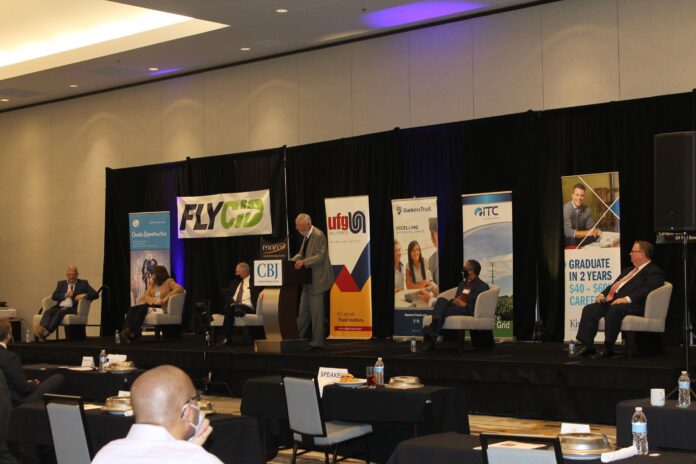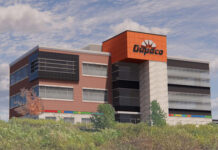
Five business leaders discussed recovery from the ‘double whammy’ of the pandemic and the derecho and how 2021 is shaping up for their industries at the CBJ Economic Forecast Luncheon Jan. 20. PHOTO KATHARINE CARLON.
Panelists at the CBJ’s 2021 Economic Forecast Luncheon began last year with strong expectations and healthy workloads. Then, just a couple months into 2020, the COVID-19 pandemic hit, shutting down businesses and sending workers home. Just as the local economy started to recover in August, a hurricane-like derecho wreaked havoc on the region, destroying homes and businesses in its path.
“It was like a double whammy,” said Joe Ahmann, president and owner of Ahmann Companies, who was joined by four other industry leaders and moderator Jack Evans of the Hall-Perrine Foundation for a discussion that ranged from the dispersal of the vaccine to the new legislative session.
Other panelists included Jennifer Bennett, president of Shive Hattery; Mike Gerdin, president and CEO of Heartland Express; Suresh Gunasekaran, CEO of University of Iowa Hospitals & Clinics; and Mike Ralston, president of the Iowa Association of Business and Industry.
Here, in a lightly edited format, are their thoughts on the challenges of 2020 and what they learned from them heading into the new year.
What do you see for 2021 after an unprecedented year with the pandemic and derecho?
Joe Ahmann:
As everybody in the room can say, 2020 was quite a roller coaster ride. We started out the year with a very strong workload, very strong models, very strong projections. And then very quickly, everything turned south. Housing and single-family design just went on hold immediately. It was quickly followed by some commercial design work that was going on, but was put on hold. Fortunately, on our commercial construction side, we had a large backlog of projects, so we were able to work through that. The commercial real estate side was quite a challenge dealing with the fallout of COVID and businesses that were forced to close.
My big concern moving forward is if there’s any other long-term or even short-term mandatory shutdown of businesses and industries. That could be a devastating effect, that the recovery for a lot of those small businesses may not be as fortunate as in round one.
Jennifer Bennett:
We went into 2020 with a record backlog and just looking like it was going to be our best year ever. And January and February certainly started off that way, exceeding even our own high expectations. And then the pandemic hit, and we saw a backlog drop almost 20, 25% immediately as our clients put projects on hold or canceled them altogether. It really stayed down low until this fall, when we saw it start to rise.
Now it’s been rising steadily every month, and we’re looking at a very bright 2021. The key for us is our diversity of markets. We did have some shining stars that will continue to be shining stars: warehousing, e-commerce and multifamily continued to do really well, probably because of the low interest rates. Education might still have a really rough 2021 as it’s dealing with a dramatic drop in income, but we’re seeing other sectors come back online and really looking for a bright 2021.
Mike Gerdin:
We have been busier than we can ever imagine in the back half of 2020 and into 2021 as we go forward. We can’t haul any more loads; we’ve got all that we can do. We had over 9,000 turndowns last week, which are loads that we turned down because we just simply don’t have enough capacity for them.
It’s an odd read on the economy; there are parts of this economy that are really suffering and hurting. If you’re a restaurant or bar, or an airline or rental car company, it’s not good. But our customers are like Georgia Pacific. They make toilet paper and paper towels. Clorox – they make hand wipes. Home improvement projects for the nation have gone through the roof. The amount of beer that is being consumed in America right now is up like 30%. So, parts of this economy are going gangbusters. And there’s other parts that are really suffering. But for the customers that we have, and the users that we serve, I don’t see an end in sight. People are going to continue to consume and consume.
Suresh Gunasekaran:
It’s been a very, very difficult year emotionally. For our staff, workload wise, it’s been a tough year; we’ve stayed pretty full. We’ve had this unique combination of the amount of money that we get from the state [$0]. We run as a business, and when we have mandatory shutdowns, that’s revenue that we don’t make. When we’re overrun with COVID patients, it is, in fact, less profitable for us because we make more money on the non-COVID services than we do the COVID services. So we’ve had pay cuts and other financial things for our health care workers. On the front lines these workers that have had to show up every single day have also had to face economic hardship. During the first phase of the pandemic, they were able to get through it with the remarkable support of the community. The second phase, though, got tiring, because the pandemic just took too long, and it continues to degrade on people.
The holiday season was really difficult, because we stayed really busy during Thanksgiving and Christmas time. But there is hope, and there is light at the end of the tunnel. The vaccine has very much lifted everyone’s spirits; they see that this pandemic can come to an end. I think the only thing holding back our employees right now from really getting to a happier spot is the fact that we’re not able to offer it to patients. Once we’re able to offer the vaccines to large numbers of patients, I think the employee morale will come back up in the building.
Mike Ralston:
Our members are pretty optimistic about 2021. The quarterly survey we did in December for the first quarter of 2021 was very optimistic. We represent about 1,500 member companies across the state, primarily manufacturers. They expect sales to be up; they expect employment to be up; 70% of them are going to make capital expenditures. So that’s a big deal: a new piece of multimillion dollar equipment, plant expansion. We don’t know how long it’s going to last. But for the first quarter, half of the year, people are pretty bullish.
What are the consequences of working from home going to be on the commercial real estate market?
Joe Ahmann:
You hear a lot of experts and a lot of things on the news about how companies feel that their efficiency has either stayed the same or gone up by people working at home. I’ve got my own personal opinion. People are inherently social individuals; we’re social people, and sitting at home, working at an office over time, is not a good thing. It’s a negative thing and it affects how people think. They start to question whether they like their job or don’t like their job. And we’re seeing a lot of people in our company and other companies that have hinted around looking for things because they’re looking for something to make things feel better or different.
We have had numerous companies contact us to say, ‘Hey, we want to reduce our footprint by 50%.’ I try to caution companies from making too quick of a decision. I‘ve seen that happen in the past with trends in the industry: changing of office space to more open space and going into no-office concepts and some of those things. And then a few years later, we’re getting calls back because now we want to rebuild it and put things back in because it doesn’t really work. Instead of getting the cart ahead of the horse, let’s be patient, let’s take our time, let’s work together and figure out other solutions.
How have sustainability initiatives affected the products you’re working on?
Jennifer Bennett:
As we look at how we use our natural resources, our buildings and our infrastructure are one of our largest uses of our natural resources. With architects and engineers, we are laser-focused on that right now and consider ourselves stewards of our natural resources. There’s a lot of emphasis on sustainability right now, and that’s really looking at that from cradle to grave in the life of the project. Are we being responsible on how we’re siting projects and how we’re handling the water? Can we improve things through design and not just not harm them? Are we designing and building buildings that will last, or are we still going to build these disposable buildings that we tear down after 20 years? Those are the things that are top of mind for us, and a big emphasis right now.
What are some new technology concepts in the trucking industry?
Mike Gerdin:
Manufacturers have made these trucks so much better in the last five years, in terms of aerodynamics, carbon emissions and better fuel mileage. It’s constantly evolving in the industry, and I give a lot of credit to the OEMs [original equipment manufacturers] that are out there and the trucking companies that are really trying to get better. The trucks are so much better now than they were five years ago. Same thing with trailers and tires. It’s all cost savings for truckers. We want to be as efficient as we can, and we want to use the best technology that’s out there because it’s really better for everyone.
What is the status of the COVID-19 vaccine at UIHC?
Suresh Gunasekaran:
We’ve been pretty successful at vaccinating our own employees. The health care workers represent the front lines and we have about 10,000 health care workers on the front lines at UIHC, and we’ve been through about 85 to 90% of them. We anticipate concluding that this month. Our attention is really turned to what we’ve really wanted to focus on, which is patient vaccination.
So we’re working with Johnson County Public Health, as well as the Iowa Department of Public Health,to make sure that as vaccination for patients open in Iowa, with a prioritization toward older individuals and those with pre-existing health conditions of significance, as well as front line, first responders and others, we want to make sure that we are prepared to be able to not only vaccinate, but vaccinate quickly. The experiments that we’ve been running operationally is how could we vaccinate thousands of people on a single day in order to support the community and our businesses and allow us to get back to a more normal society.
What are the top legislative initiatives from the API for this year?
Mike Ralston:
From our perspective, those kinds of things that enhance the state’s infrastructure and workforce are the most important. The good news is legislators of both parties in both chambers are talking about expanding broadband, which is important for the state. There’s also talk about putting more money into workforce training programs.
We also have a real issue in Iowa with quality, affordable child care. We’re encouraged that the legislature and the governor see that as an issue that needs to be addressed.




